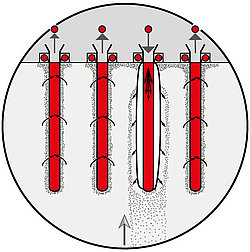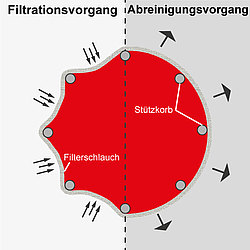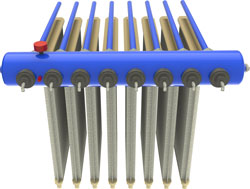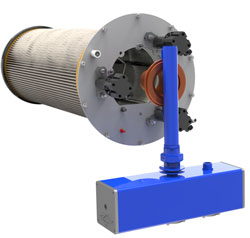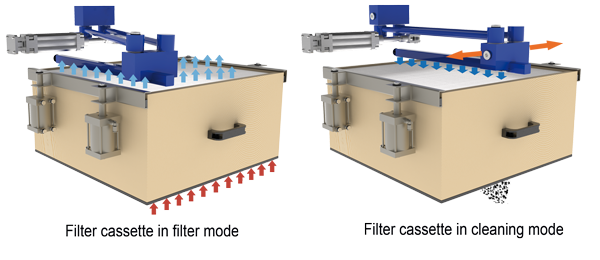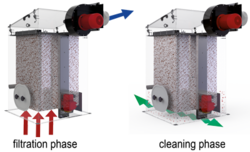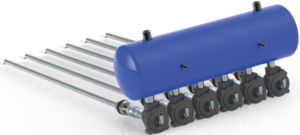Filter cleaning
With the first dust separators, cleaning was carried out manually, afterwards by vibration, then from purging air to devolpment and establishment of pressurized air cleaning (jet-pulse cleaning). The transition from processes with purged air cleaning to jet-pulse cleaning has (because of the efficient separation of the periodic deposited filter cake) significantly contributed to increase the areas of application and higher air-to-cloth ratio.
Dust separator cleaning mechanisms
In the mechanical separation of dust particles and gas at the filter element, the growing dust layer on the surface of the filter element results in a pressure difference (filter resistance). In order to prevent a certain pressure difference (normally < 1,500 Pa) from being exceeded, the filter elements must be periodically cleaned.
The type of cleaning is, in addition to the form and arrangement of the filter media, the central design feature of a filter. Cleaning mechanisms include mechanically moving the filter medium, reversing the gas flow, transferring momentum to the dust cake, or a combination of these mechanisms.
Online cleaning
When distiguish online and offline cleaning principles, only the filter element cleaning within one filter chamber is considered. Online cleaning means that element are cleaned, while the adjacent filter elements filter at the same time.
The principle of online cleaning is based on two effects:
- The dust cake is catapulted so far away from the filte element, that it either reaches immediately the area of dust discharge, or at least deposits centimeters below the starting point.
- At the lowest area of the filter elements, the filtered dust must fall during the cleaning impulse in an agglomerated form by a process gas pointed upwards. This so-called terminal velocity is therefore a decisive design parameter of a filter system.
Requirement of the online principle is therefore a high energetic filter cleaning, which can be easily realised with a jet-pulse system.
Ill.: Cleaning during online operating.
The bag rows 1,2 and 4 are in filtration process, whereas bag row 3 is cleaned at the same time.
Offline cleaning
Offline cleaning has not the effects as online cleaning. Even finest not agglomerating dusts reach after release from the filter medium the dust discharge by sedimentation in a flow-free area. Depending on the design and dust fineness, the cleanable dust gets enough time to sediment (setting period) in order to prevent that the process gas gathers the falling dust again.
An offline cleaning is necessary for:
- special filter cleaning kinds, when the filter cake is only released from the filter medium and afterwards sediments into the dust discharge, e.g. cassette filter or shaking filter
- very fine dusts which badly agglomerate, so that even low velocities bring back the cleaned dust onto the filter
Offline cleaning is especially effective for fine dusts and dust mixtures with a high air-borne-dust part and is popular to use at the end of a process - also additionally to online cleaning. Accumulated fine dust parts at the filter are effectively cleaned then.
Filter cleaning bag filter and pocket filter
Bag filters and pocket filter have next to pulse-shaped reverse flow during filter cleaning a further positive effect. The cleaning behaviour especially with procedural critical dust which protrudes over all other filter element kinds.
During filtration, the flexible filter medium is sucked on the supporting cage and builds up, together with the developing filter cake - a concave shape. Because of the cleaning impulse, this shape is changed into a convex form and the filte medium is expanded to a maximum possible size. The adjacent filter cake breaks through this (in addition to the blowing impulse) and even heavy adjacent filter cakes detach from the filter medium.
Ill.: Filtration and cleaning process of a filter bag cleaned by pressurized air
Filter cleaning cartridge filter with vertical installation and pleated element filter
Filter cartridges and pleated elements are just like bag filters cleaned by jet-pulse and online. the cleaning impulse must be so strong, that the dust existing in a folding is blown off from the filter foldings in an efficient way. The supporting movements of the filter medium during cleaning (just like bag filter and pocket filter) are not existing. An decisive influence on cleaning efficiency has the geometrie of a folding. Big tip distances and flat foldings faciliate cleaning. small tip distances and deep foldings have the opposite effect.
The realized filter surface of a pleated filter element behaves in inverse proportion. Because of economic reasons, always a process-oriented compromise of optimum filter geometry and maximum possible filter surface must bbe found.
Besides the above described jet-pulse cleaning, there exist also rotating back-flushing systems for cartridges and even mechanical systems, which are not considered at this point because of existing disadvantages.
Ill.: Vertical pleated element filter with cleaning system
Filter cleaning with horizontal installation
Horizontal installed filter cartridges are a special case within the great amount of cartridge filters. The jet-pulse cleaning is unchanged, but only the lower 2/3 of a cartridge is cleaned in such a way, that the dust reaches effectively the dust discharge.
Without supporting measurements the dust of the upper third would fall back onto the filter directly after the blowoff. In order to use this lost filter surface permanently, Infastaub has developed in addition to jet-pulse cleaning a raw-gas-side nozzle system. The dust blown off from the foldings is removed from the upper part of the filter cartridges and can deposit. This additional measurement is especially effective within a flow-free room, so that offline cleaning is part of this concept.
Ill.: Horizontal cartridge filter with cleaning system
Filter cleaning cassette filter
After testing initially shaking cleaning, it showed fast that also with this filter design a pneumatic cleaning is more effective. Because of the cassette geometrie the principles of jet-pulse cleaning and online cleaning became inapplicable. It is understandable with folding heights up to 300 mm, that a cleaning impulse within milliseconds can't be sufficient enough in order to blow off dust particles over such a distance. The logical consequence out of this is an offline cleaning. Only this way separated particles from the filter medium have the possibility to deposit ou of the depth of a filter cassette. Since cassettes are mostly designed as filter for suspended matters and finest particles can be expected therefor, the depositing time of bad agglomerating dusts can be rather long (up to 5 min).
During filter cleaning a nozzle pipe is guided parallel to the filter folding over the cassette surface. Therefore, a pressure shock results for each single filter folding combined with a slight mechanical movement of the filter medium.
Ill.: Cassette filter with cleaning system and clamping device
Cleanable filters with mechanical cleaning
Cleaning is done with a motor-actuated vibration device. With automatic cleaning, a motor is activated to vibrate the filter element once the maximum filter resistance has been reached or a specified period of time has elapsed. The dust cake detaches from the filter fabric and falls down into a collection container, which is regularly emptied or removed. Cleaning can be done only while the filtration operation is switched off (offline cleaning).
The filter media are subjected to high mechanical loading when cleaned with vibrations. Since shaking filters can only be used intermittently and are not designed for continuous use, the filter media – depending on the mode of operation – can have a service life of up to five years, sometimes even seven years.
Cleanable filters with back-flush cleaning
Back-flushing is used for mechanically sensitive filter media (e.g., filter cassettes) that would be damaged by vibration or jet pulse cleaning. Cleaning is done with a partially directed flow reversal, wherein the filter medium is gradually blown clean from the clean gas side and the dust cake is removed and transported downward. This type of cleaning also can only be done offline. The filter system is usually designed with multiple chambers and is cleaned chamber by chamber (offline cleaning). The filter media can last many years due to their low mechanical loading.
Cleanable filters with jet pulse cleaning
The most commonly used and most modern method for cleaning filtration separators is the pressure shock method (jet pulse cleaning). This cleaning method has largely become the standard. Jet pulse cleaning involves an intense blast of compressed air that suddenly reverses the flow direction, briefly expanding the filter elements and removing the dust cake via momentum transfer.
During the filtration phase, the gas flows through the filter media (e.g., bags or pockets) from the outside inward; a support frame provides the element with the appropriate stability. Depending on dust load, cleaning with pressure shocks occurs every 1 to 10 minutes. The cleaning is normally regulated by measuring the pressure difference of the filter.
